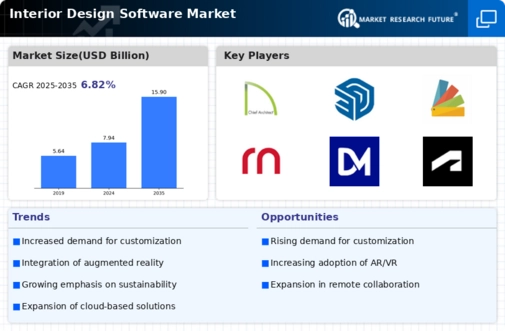Emergence of Remote Work Trends
The rise of remote work trends has transformed the Global Interior Design Software Market Industry. As more individuals work from home, there is a growing need for functional and aesthetically pleasing home office spaces. Interior design software enables users to design and optimize their work environments, catering to both productivity and comfort. This shift in work culture has led to an increased demand for design solutions that address the unique needs of home offices. Consequently, the market is likely to see sustained growth as more consumers invest in creating conducive workspaces within their homes.
Growth of the Real Estate Sector
The expansion of the real estate sector significantly influences the Global Interior Design Software Market Industry. As urbanization accelerates and new residential and commercial projects emerge, the demand for interior design services rises correspondingly. Real estate developers increasingly rely on design software to create appealing spaces that attract buyers and tenants. This trend is expected to contribute to the market's growth, with projections indicating a substantial increase in value over the next decade. The synergy between real estate development and interior design software indicates a robust future for the industry.
Rising Demand for Home Renovation
The Global Interior Design Software Market Industry experiences a notable surge in demand driven by the increasing trend of home renovations. As homeowners seek to enhance their living spaces, the need for sophisticated design tools becomes apparent. In 2024, the market is projected to reach 7.94 USD Billion, reflecting a growing interest in personalized and functional interior designs. This trend is further supported by the rise of DIY culture, where individuals utilize software to visualize their ideas before implementation. The ability to create detailed 3D models and layouts empowers users, thereby propelling the market forward.
Increased Focus on Sustainable Design
Sustainability is becoming a central theme in the Global Interior Design Software Market Industry. As environmental concerns rise, designers are increasingly incorporating eco-friendly materials and practices into their projects. Software that facilitates sustainable design choices, such as energy-efficient layouts and material sourcing, is gaining traction. This shift not only meets consumer demand for greener solutions but also aligns with regulatory trends promoting sustainability in construction and design. The market's growth trajectory, projected to reach 15.9 USD Billion by 2035, suggests that sustainability-focused software will play a pivotal role in shaping future design practices.
Technological Advancements in Design Software
Technological innovations play a crucial role in shaping the Global Interior Design Software Market Industry. The integration of artificial intelligence and virtual reality into design software enhances user experience and design accuracy. These advancements allow designers to create immersive environments, enabling clients to visualize spaces before actual construction. As the software evolves, it becomes increasingly user-friendly, attracting a broader audience. The anticipated growth from 2025 to 2035, with a CAGR of 6.53%, indicates that these technological enhancements are likely to drive market expansion significantly, as more users adopt advanced design tools.





















